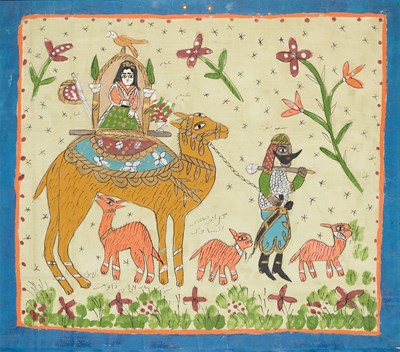1st May, 2024 12:00
Modern and Contemporary African and Middle Eastern Art
67
ABU SUBHI AL TINAWI (SYRIAN 1888-1973)
ABLA & SHEIBOUB
signed in Arabic lower centre
mixed media on canvas mounted onto board
60 x 69cm; 24 x 27 1/4in
64.5 x 72.5cm; 25 3/4 x 28 1/2in (framed)
Executed circa 1950s/1960s.
Property from a Private Collection, London
Provenance
Collection of a Diplomat, Dubai
Acquired from the above by the present owner
Born in Damascus, Abu Subhi Al Tinawi is one of the most well-known Syrian folk artists of his time. Originally named Muhammad Harb, it was when he opened his shop in Damascus that he began signing all of his artworks Abu Subhi Al Tinawi.
Hailing from a family of reverse glass-painters and tapestry artisans, Al Tinawi made his own paint by combining natural pigments with Arabic gum. He became known for reverse glass painting, a technique which originated in Europe and was popularised in Central and Eastern Asia in the 17th century. Continuing his work on glass and other media, such as metallic paper or cloth, he used bright colours and simple representations of characters with straightforward expressions. Fascinated by traditional verses and stories, Al Tinawi’s oeuvre explores folk epics, historical events and religious themes.
Rumoured to be one of the first Arab artists to participate in an exhibition showing Picasso in Paris, his work was acquired internationally by individuals and art institutions, including the Louvre, and has appeared in numerous publications and films.
ABLA & SHEIBOUB
signed in Arabic lower centre
mixed media on canvas mounted onto board
60 x 69cm; 24 x 27 1/4in
64.5 x 72.5cm; 25 3/4 x 28 1/2in (framed)
Executed circa 1950s/1960s.
Property from a Private Collection, London
Provenance
Collection of a Diplomat, Dubai
Acquired from the above by the present owner
Born in Damascus, Abu Subhi Al Tinawi is one of the most well-known Syrian folk artists of his time. Originally named Muhammad Harb, it was when he opened his shop in Damascus that he began signing all of his artworks Abu Subhi Al Tinawi.
Hailing from a family of reverse glass-painters and tapestry artisans, Al Tinawi made his own paint by combining natural pigments with Arabic gum. He became known for reverse glass painting, a technique which originated in Europe and was popularised in Central and Eastern Asia in the 17th century. Continuing his work on glass and other media, such as metallic paper or cloth, he used bright colours and simple representations of characters with straightforward expressions. Fascinated by traditional verses and stories, Al Tinawi’s oeuvre explores folk epics, historical events and religious themes.
Rumoured to be one of the first Arab artists to participate in an exhibition showing Picasso in Paris, his work was acquired internationally by individuals and art institutions, including the Louvre, and has appeared in numerous publications and films.
Auction: Modern and Contemporary African and Middle Eastern Art, 1st May, 2024
Viewing
PUBLIC EXHIBITION
Sunday 28th April 12:00pm - 4:00pm
Monday 29th April 10:00am - 8:00pm
Tuesday 30th April 10:00am - 5:00pm



